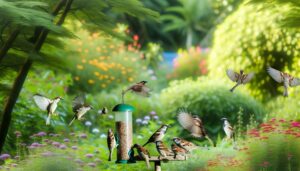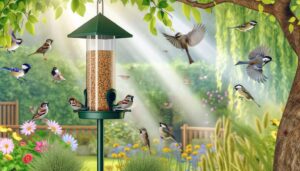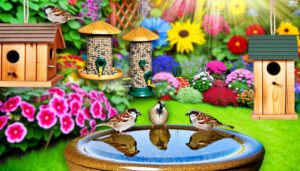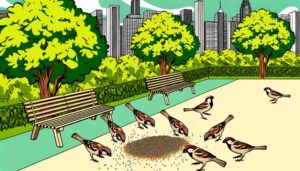How Do House Sparrows Get Sick?
House sparrows are susceptible to a range of health risks primarily caused by pathogenic bacteria such as Salmonella spp., transmitted through contaminated food and water. Viral threats include avian pox and West Nile virus, leading to skin lesions and neurological issues, respectively.
Parasitic infestations from mites, lice, and intestinal worms are prevalent, with transmission via direct contact or contaminated environments. Fungal infections, notably aspergillosis, compromise respiratory health.
Environmental stressors such as pesticide-laden seeds and pollutants exacerbate health issues, causing toxicity and immune dysfunction. For a deeper understanding of these health challenges, further exploration reveals extensive insights.
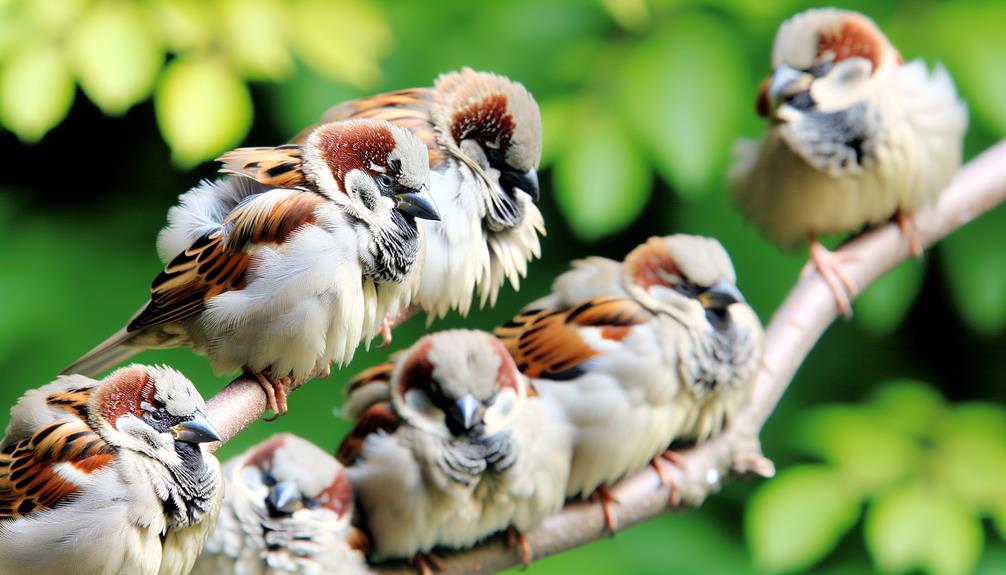
Key Takeaways
- House sparrows get sick by ingesting contaminated food and water, leading to bacterial infections like Salmonella.
- Viral diseases such as avian pox and West Nile virus cause skin lesions and neurological issues in house sparrows.
- Parasites including mites, lice, and intestinal worms infest house sparrows through direct contact or contaminated environments.
- Fungal infections like aspergillosis affect house sparrows' respiratory systems, causing labored breathing and lethargy.
- Environmental contaminants like pesticides and heavy metals in food sources lead to acute toxicity and chronic health problems in house sparrows.
Bacterial Infections
Bacterial infections in house sparrows (Passer domesticus) often result from exposure to pathogenic bacteria such as Salmonella spp., leading to notable health complications and increased mortality rates within affected populations. Observational studies indicate that these infections primarily occur through contaminated food and water sources.
Clinical manifestations include lethargy, ruffled feathers, diarrhea, and dehydration, impairing the bird's ability to thrive significantly. Epidemiological data reveal infection rates as high as 30% in densely populated urban environments.
Laboratory analyses confirm bacterial presence through fecal cultures, with subsequent identification via polymerase chain reaction (PCR). Intervention strategies emphasize the importance of maintaining clean feeding stations and water sources to mitigate exposure.
Such measures are critical to preserving the health and viability of house sparrow populations.
Viral Diseases
Viral diseases in house sparrows, especially avian pox and West Nile virus, present important health threats, manifesting through symptoms such as lesions, neurological impairment, and reduced survival rates in affected populations.
Avian pox, caused by avipoxvirus, leads to proliferative lesions primarily on the skin and mucous membranes, impairing feeding and flight.
West Nile virus (WNV), a flavivirus, induces encephalitis and other neurological dysfunctions, significantly affecting avian morbidity and mortality. Studies indicate infection rates can exceed 30% in local populations during outbreaks.
Both diseases contribute to decreased reproductive success and increased predation due to impaired mobility.
Monitoring viral load and transmission dynamics is essential for understanding and mitigating the impacts of these pathogens on house sparrow populations.
Parasitic Infestations
House Sparrows are frequently afflicted by parasitic infestations, with common parasites including mites (Dermanyssus gallinae), lice (Menacanthus stramineus), and various species of intestinal worms. Transmission typically occurs through direct contact with infected individuals or contaminated environments, leading to symptoms such as feather loss, anemia, and decreased reproductive success.
Data from recent studies indicate infestation rates as high as 60% in urban populations, underscoring the significant impact on their health and survival.
Common Parasites Identified
Among the myriad of parasitic infestations affecting Passer domesticus, mites, lice, and intestinal protozoa are the most commonly identified parasites.
Mites, such as Ornithonyssus sylviarum, adhere to the skin and feathers, causing irritation and potential feather damage.
Lice, particularly Menacanthus stramineus, feed on blood and skin, leading to anemia and decreased fitness.
Intestinal protozoa, including species like Trichomonas gallinae, inhabit the gastrointestinal tract, disrupting nutrient absorption and causing severe enteric symptoms.
Empirical studies indicate a prevalence rate of 40-60% for these parasites in urban sparrow populations.
Detailed microscopic examinations and molecular diagnostics have enhanced our understanding of these parasitic loads, aiding in the development of targeted interventions to mitigate their impact on sparrow health.
Transmission and Symptoms
Transmission of parasitic infestations in Passer domesticus occurs primarily through direct contact with infected individuals or contaminated environments, leading to a cascade of clinical symptoms that can include feather loss, anemia, and gastrointestinal distress.
Ectoparasites such as mites and lice attach to plumage, compromising feather integrity and causing significant feather loss.
Endoparasites, including various nematodes and cestodes, can induce anemia by disrupting hematopoiesis.
Gastrointestinal parasites like coccidia result in malabsorption and diarrhea, further weakening the host.
Field studies have shown a prevalence of parasitic infections in up to 60% of sampled populations, correlating with increased morbidity.
Detailed observation underlines the necessity for targeted control measures to mitigate the impact of these infestations on sparrow health and survival.
Fungal Infections
Fungal infections in house sparrows, primarily caused by Aspergillus species, greatly affect their respiratory systems, leading to a condition known as aspergillosis. This mycotic disease is characterized by granulomatous lesions in the lungs and air sacs. Clinical symptoms include labored breathing, lethargy, and decreased vocalization. Pathological studies indicate that immunocompromised individuals are particularly susceptible.
| Parameter | Observation |
|---|---|
| Pathogen | Aspergillus species |
| Affected System | Respiratory |
| Clinical Symptoms | Labored breathing, lethargy, decreased vocalization |
| Susceptibility | Higher in immunocompromised birds |
| Pathological Features | Granulomatous lesions in lungs and air sacs |
Understanding these fungal infections is critical for developing effective treatment and prevention strategies, thereby enhancing avian health and survival rates.
Environmental Stressors
Environmental stressors, including habitat degradation, pollution, and climate change, impact the health and population dynamics of house sparrows to a large extent. Habitat degradation reduces nesting sites and feeding grounds, directly affecting reproductive success and juvenile survival rates.
Pollutants, especially heavy metals and pesticides, disrupt physiological functions, leading to increased mortality and reduced fitness. Data show a correlation between urbanization and elevated levels of lead in sparrow tissues, impairing neurological and immune systems.
Climate change exacerbates these issues by altering food availability and weather patterns, imposing additional energetic costs. Studies indicate that extreme weather events, such as heatwaves and storms, result in higher mortality rates, further stressing already vulnerable populations.
Poor Nutrition
Nutritional deficiencies in house sparrows, specifically the lack of essential nutrients such as proteins and vitamins, have been linked to decreased immune function and increased susceptibility to diseases.
Moreover, observational data indicate that contaminated food sources, often laden with pesticides or heavy metals, exacerbate these nutritional deficits by introducing toxic substances into their diet.
Consequently, these factors play a substantial role in the overall decline in the health of house sparrow populations.
Lack of Essential Nutrients
Deficiencies in essential nutrients, such as proteins, vitamins, and minerals, can greatly compromise the immune system of house sparrows, making them more susceptible to diseases. Research highlights several critical impacts of poor nutrition:
- Immune Function Degradation: Nutritional deficits impair the production of antibodies and white blood cells, reducing the bird's ability to fight pathogens.
- Reproductive Challenges: Malnutrition is linked to lower reproductive success rates, as nutrient-deprived sparrows produce fewer and less viable eggs.
- Delayed Growth and Development: Young sparrows experiencing nutritional deficiencies often show stunted growth and delayed development, making them more vulnerable to predation and disease.
Empirical studies underscore the necessity of a balanced diet to maintain peak health and disease resistance in house sparrows.
Contaminated Food Sources
Contaminated food sources, such as those tainted with pesticides or heavy metals, pose significant health risks to house sparrows by introducing toxic substances into their diet. Field studies have demonstrated that ingestion of pesticide-laden seeds can lead to acute toxicity, manifesting as neurological impairments, reduced reproductive success, and increased mortality rates.
Additionally, bioaccumulation of heavy metals like lead and mercury in sparrows can result in chronic health issues, including nephrotoxicity and impaired immune function. Observational data indicate that contaminated food sources also contribute to a decline in the overall health and population numbers of house sparrows.
Consequently, monitoring and mitigating environmental contaminants are imperative for the conservation of this species and maintaining ecological balance.
Human Impact
The decline in house sparrow populations has been significantly worsened by urbanization, which has led to habitat loss, pollution, and decreased availability of food sources. Human impact manifests in various harmful ways:
- Habitat Fragmentation: Urban development disrupts natural habitats, reducing nesting sites and shelter.
- Pollution: Air and water contaminants weaken immune systems, making sparrows more susceptible to diseases.
- Altered Food Supply: Pesticides and reduced green spaces diminish insect populations, which are essential for sparrow nutrition.
Studies indicate that urban noise pollution also interferes with their communication, further impeding their ability to thrive. Data shows a significant correlation between high-density urban areas and declining sparrow numbers, emphasizing the need for conservation efforts to mitigate human impact.
Conclusion
In summation, the myriad afflictions besetting house sparrows—ranging from bacterial invasions to the insidious grasp of parasitic entities—highlight an avian existence fraught with perilous variables.
Environmental perturbations and nutritional inadequacies further exacerbate their plight, while anthropogenic activities serve as a proverbial confirmation of their resilience.
It is, indeed, a confirmation of the resilience of Passer domesticus that they persist amidst such an onslaught of adversities.
The avian struggle against these multifaceted threats underscores a delicate, ever-precarious balance within urban ecosystems.

